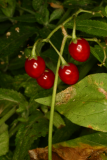Additional notes (click to expand)
Phytochemistry
Active principle: green fruits and leaves contain steroidal glycoalkaloids such as soladulcidine, solanine,
solasodine, chaconine etc., saponins.
Wink, M. (2009). Mode of Action and toxicology of plant toxins and poisonous plants. Mitt. Julius Kuhn-Inst. 421:93-111.
Toxicity
Class Ib-II poison - highly to moderately poisonus - disturbance of GI tract, vomiting, spasms, internal bleeding, salivation, trembling, restlessness, headache, delirium, fever and coma. In severe cases death may occur through respiratory arrest
Wink, M. (2009). Mode of Action and toxicology of plant toxins and poisonous plants. Mitt. Julius Kuhn-Inst. 421:93-111.
Humans/Pets: Harmful if eaten
HTA Guide to Potentially Harmful Plants, 3rd Edition (2022)
Geographical distribution
- Africa, Northern Africa
- Asia-Temperate, Caucasus
- Asia-Temperate, China
- Asia-Temperate, Middle Asia, Turkmenistan
- Asia-Temperate, Mongolia, Mongolia
- Asia-Temperate, Russian Far East
- Asia-Temperate, Siberia
- Asia-Temperate, Western Asia, Afghanistan
- Asia-Temperate, Western Asia, Iran
- Asia-Temperate, Western Asia, Iraq
- Asia-Temperate, Western Asia, Israel
- Asia-Temperate, Western Asia, Jordan
- Asia-Temperate, Western Asia, Lebanon-Syria
- Asia-Temperate, Western Asia, Turkey
- Asia-Tropical, Indian Subcontinent
- Europe, Eastern Europe
- Europe, Middle Europe
- Europe, Northern Europe
- Europe, Northern Europe, Great Britain
- Europe, Southeastern Europe
- Europe, Southwestern Europe
Solanum dulcamara L.
Family: SOLANACEAEGenus: Solanum
Species: dulcamara L.
Common names: Woody Nightshade
Distribution summary: N. Africa, Eurasia
Habit: Perennial
Hardiness: H5 - Hardy; cold winter
Habitat: Moist woodland and riverbanks
Garden status: Currently grown
Garden location: Plane tree bed (P)
Flowering months: May
Reason for growing: Toxic

